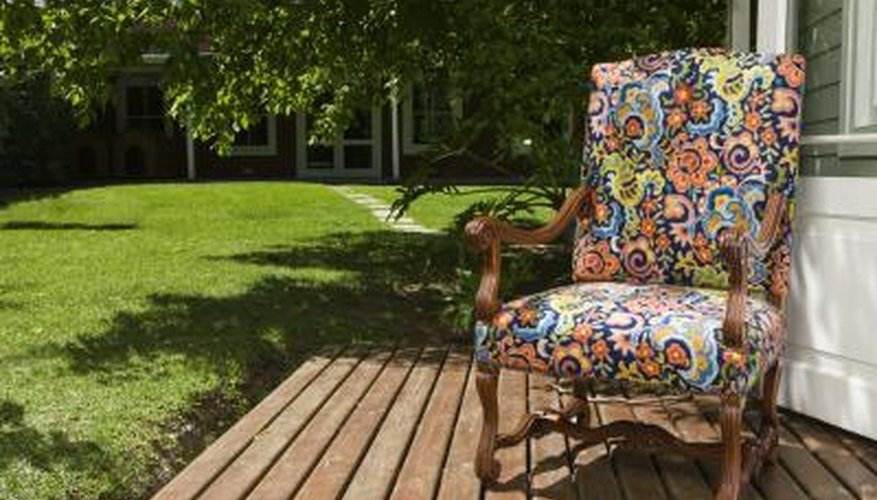Several different tree species may be called cedar for the lumber market. These include North American red and white cedars, actually members of the cypress family; European true cedars; and Australian red cedar. Each of these woods has a number of benefits, including attractive colour, fast growth and durability. However, not all cedar woods are the same, and all come with a few disadvantages.
Western Red Cedar
One of the most common "cedar" woods on the market, western red cedar is actually a close relative of the juniper bush. It's also called canoe cedar and giant cedar, and produces white sapwood and pink to red-brown heartwood. It has a strong smell and is difficult to treat with preservative chemicals. Its sawdust can cause skin and respiratory irritation, and the acids in the wood may corrode iron or steel fasteners. Western red cedar is light and tends to resist rot, but these traits are strongest in old trees. Younger lumber may not be as durable.
- One of the most common "cedar" woods on the market, western red cedar is actually a close relative of the juniper bush.
- Western red cedar is light and tends to resist rot, but these traits are strongest in old trees.
Eastern Red Cedar
This juniper relative grows in the eastern half of North America and is also called red juniper, aromatic cedar, and Virginia pencil cedar, for its use in wooden pencils. It produces wood similar to western red cedar, with a milder smell and similar decay resistance. This tree's thin bark makes it vulnerable to fire while growing. It is also a host for cedar-apple rust disease. The wood itself machines and polishes well but can produce a mild skin irritation in sensitive people.
- This juniper relative grows in the eastern half of North America and is also called red juniper, aromatic cedar, and Virginia pencil cedar, for its use in wooden pencils.
Eastern White Cedar
This member of the cypress family grows in the eastern parts of the United States and Canada and has traditionally been used for boat building and outdoor projects. It produces narrow white sapwood and straw-coloured heartwood. The wood tends to be knotty, with a strong cedar smell. It resists preservative treatments and is relatively weak. The wood is soft, making it a poor choice for flooring and other high-wear uses. Eastern white cedar wood holds screws and nails poorly, tends to break when bent and, like the red cedars, may cause skin irritation in sensitive people.
- This member of the cypress family grows in the eastern parts of the United States and Canada and has traditionally been used for boat building and outdoor projects.
- Eastern white cedar wood holds screws and nails poorly, tends to break when bent and, like the red cedars, may cause skin irritation in sensitive people.
Atlantic White Cedar
Usually used for boats, crates and other rough building, Atlantic white cedar is also called swamp cedar and false cypress. It produces white sapwood and light brown to red heartwood with a fine grain and strong odour. It strongly resists preservative treatments and is very soft. Atlantic white cedar has a poor bending strength and tends to break under pressure. It also compresses poorly.
- Usually used for boats, crates and other rough building, Atlantic white cedar is also called swamp cedar and false cypress.
- It strongly resists preservative treatments and is very soft.
Australian Red Cedar
This wood is also known as toon, epi, Indian cedar and simply red cedar. Native to Australia, southeast Asia and the Pacific islands, it is considered an exotic wood in the United States and priced accordingly. This tree produces pink to pale yellow sapwood and reddish-brown heartwood with darker streaks and straight to interlocked grain. Though it is not related to North American cedars, it has a similar spicy smell. The wood sometimes accepts preservative treatment but can be highly unpredictable. Australian red cedar may suffer from gummy deposits and abnormal growth, and the sawdust causes skin irritation in some people. This wood is moderately soft and has poor compression strength parallel to the grain. It can gum cutting tools, blunt saw blades and produce woolly finish when sanded.
- This wood is also known as toon, epi, Indian cedar and simply red cedar.
- Australian red cedar may suffer from gummy deposits and abnormal growth, and the sawdust causes skin irritation in some people.
Spanish Cedar
Also known as Brazilian cedar, Central American cedar and cedre rouge, this tree is native to Central and Latin America but also grows in southeast Asia and Oceania. It produces pale sapwood and pink to dark brown heartwood with a coarse texture. Heartwood is extremely resistant to preservative treatment, while sapwood is considered moderately resistant. Timber is often resinous and full of volatile oils, which can irritate the nose and throat in sensitive people. This relatively soft wood is hard to bore, blunts saw blades and may not hold up well to high-wear uses.
- Also known as Brazilian cedar, Central American cedar and cedre rouge, this tree is native to Central and Latin America but also grows in southeast Asia and Oceania.
- Heartwood is extremely resistant to preservative treatment, while sapwood is considered moderately resistant.
True Cedar
This European and Middle Eastern tree is also called cedar of Lebanon. It is referred to in the biblical Old Testament and has historically been used for construction and decorative items. It is not related to any of the New World trees known as "cedar." True cedar has white sapwood and warm brown heartwood, frequently with pockets of ingrown bark. The wood is soft and light, producing a strong incenselike smell. It exudes resin when steam bent and is soft and brittle. This wood is susceptible to attack by boring beetles.
- This European and Middle Eastern tree is also called cedar of Lebanon.
- The wood is soft and light, producing a strong incenselike smell.
